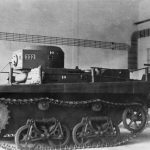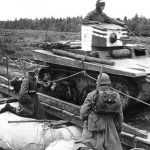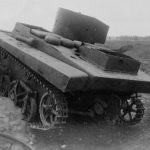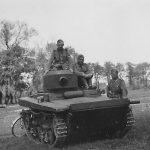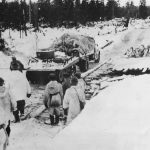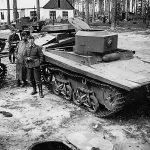Wehrmacht Infantry passing T-37A
T-37A tanks testing station at Kummersdorf
T-37A field exercise in 1936 2
T-37 3
Abandoned T-37A 1941 4
Abandoned T-37A 3
T-37A field exercise in 1935
T-37A field exercise in 1936
Wehrmacht infantry posed with T-37
Finnish Troops tow away a captured T-37 1939/1940
abandoned Russian T-37 2
T-37 Russian Amphibious Tank
T-37 Soviet Light Amphibious Tank 1941
T-37 tank stuck on the rocks, northern Eastern Front 1941-1942
Soviet T-37 Amphibious Light Tank
T-37 Soviet amphibious tank rear
Knocked out Soviet T-37 amphibious light tank and two German soldiers
Tank T-37 Brest Litowsk 1941
T-37 Soviet Light Amphibious Tanks
German soldiers examines a destroyed Soviet T-37 amphibious light tank
Abandoned Soviet T-37 amphibious light tank, left side
Tanks T-37 and T-38 Brest Litowsk 1941
abandoned Soviet T-37 Amphibious Light Tank
T-37 Soviet Light Amphibious Tank
T-37 russian amphibious light tank
Schwimm Panzerkampfwagen T-37 731 (r) Beute panzer Balkenkreuz April 1942
T-37 tank stuck on the rocks by the river, 1941-1942
Knocked-out T-37 tank at Mogilev, Eastern Front 1941-1942
Soviet T-37 Amphibious Light Tank rear view
The T-37A is a Soviet light amphibious tank (sometimes also called a tankette). In the literature, the tank is often referred to as the T-37, but formally this name was worn by another tank that did not go beyond the prototype stage. The T-37A is the first serial amphibious tank in the world.
It was created in 1932 on the basis of the British Vickers amphibious tank and experimental amphibious tanks of Soviet design. It was mass-produced from 1933 to 1936, after which it was replaced in production by the more advanced T-38 developed on the basis of the T-37A. In total during the four years of production 2566 T-37A tanks were produced, including the prototype and 75 HT-37A tanks.
In the Red Army they were intended to perform communication, reconnaissance and combat guard tasks on the march, as well as direct support of infantry on the battlefield. The T-37A were used en masse during the Polish campaign in 1939 and the Soviet-Finnish war of 1939-1940. The T-37As also participated in battles of the initial period of the German-Soviet War, but most of them were quickly lost. Single survivor tanks of this type fought at the front until 1944, inclusive, and were used in rear training units until the end of the war.
In April 1931 Vickers, in the audience of the press, successfully tested a small amphibious tank. This car was brought to a working condition by a prototype developed in the firm “Carden-Loyd Tractors Ltd”, which was bought shortly before by “Vickers”. The details of the tank’s testing published in the press and its general characteristics attracted the attention of the Motorisation and Mechanisation Department of the RKKA (UMM RKKA), as the small amphibious tank fitted well into the Red Army’s armoured vehicle armament system and in the future could replace the T-27 tank, whose combat effectiveness from the very beginning was quite low. Newspapers were delivered to OKMO of Bolshevik plant in Leningrad from Arkos company, which represented trade interests of the USSR in Great Britain, with information about the British vehicle, its photos and technical description made by Ya. Skvirsky. Based on these data, Soviet engineers found out that the running gears of the new amphibian and light tractor “Carden Loyd” purchased in 1930 are identical, and therefore their layout should be similar. On this basis, the theme of “The Drake” was opened by building its own amphibious tank with a layout similar to that of British prototypes. The prototype on the theme “The Drake”, which received the army index T-33, was built in March 1932 and showed good flotation on tests. But other points of the test program T-33 did not perform and turned out to be difficult and non-technological for the existing production base. As a result, it was not accepted for service and mass production.
But even before the construction of the T-33 it was decided to increase the amount of work on the creation of amphibious tanks and, in addition to the Leningrad OKMO, to this topic was involved in the 2nd Automobile Plant of the All-Union Automobile and Tractor Association (VATO), which at that time was already producing armored vehicles for RKKA – tanks T-27. As a result, the VATO 2nd Automobile Plant under the leadership of N.N. Kozyrev built the T-41 amphibious tank weighing 3.5 tonnes using the GAZ-AA engine (before the development of its production at the Gorky Automobile Plant, the prototype vehicles were equipped with its imported Ford-AA prototype), which was the basis of the T-27 power pack. The transmission was almost completely adopted from this tank, and for power take-off a rigid toothed clutch was added to the propeller. Its design required the tank to be stopped and the engine to be switched off. The undercarriage was to a certain extent borrowed from the T-33, and the tracks were entirely from the T-27. The Leningrad designers also continued the development of the light amphibious tank and presented their variant under the T-37 index with the same GAZ-AA engine, the transmission with a wide use of automotive components and the Krupp type running gear, with which the Soviet engineers got familiar in the course of military-technical cooperation with Weimar Germany. Although an order for a small series T-41 was even issued, as a result of lengthy military tests, both he and T-37 were rejected by the army due to a large number of various shortcomings and defects.
Meanwhile, it was possible to study the British prototype in detail. His Majesty’s War Office abandoned the Vickers amphibian, so the company decided to offer this machine to the foreign market. USSR on February 5, 1932 made an offer through a representative of the company “Arkos” Ya. Skvirsky to buy 8 amphibians. Negotiations on the deal did not drag on, and already in June 1932 the firm supplied the first two tanks to the Soviet side.
At the same time, work continued on the domestic light amphibious tank. As a result of experience gained during the construction of the T-41 and T-37, it was decided to adopt a kind of “hybrid” of these two vehicles: the layout scheme to borrow from the first, and the running gear – from the second. By the Decree of the USSR Council of Labour and Defence (STO) of August 11, 1932 such a tank under the T-37A index was adopted by the Red Army, and at the time of approval there was not even a prototype tank. N.N. Kozyrev was appointed chief designer of the tank, which did not yet exist, and mass production was planned to be launched at the 2nd Automobile Plant VATO in Cherkizov. It is a common view that the T-37A was a copy of the Vickers amphibian, given the purchase of this car by the USSR. However, the above course of events refutes this statement literally, but it is unquestionable that the British vehicle clearly served as a prototype for the T-37A, having a strong influence on the design of the latter by its layout and technical solutions of the chassis.
Even before the end of 1932, the highest leadership of the RKKA planned to get the first 30 serial T-37A. For faster development of the plant number 37 (as the 2nd Automobile Plant WATO became known) transferred all the developments of OKMO on the T-37 and one amphibious tank “Vickers-Carden Loyd” purchased in the UK. In 1933 the plan of 1200 T-37A was defined for plant No 37. However, subsequent events showed excessive optimism of the management of the Special Machine Building Trust, to which Plant No 37 belonged. The trust itself was created as a managing body to coordinate large-scale efforts to develop new models of armored vehicles at a number of plants in the country and later played a significant role in the successful implementation of this task, but as of early 1933, it could not overcome the “top-down” level of technical equipment of plant number 37 by purely organizational measures.
The T-37A was much more complex than the T-27 tank, which immediately created great difficulties both for Plant No. 37 and its neighbor, the Podolsk Cracking-Electric Locomotive Plant ( KES), which was supposed to manufacture armoured bodies for the T-37A. Besides, in 1933 the T-27 tank remained in mass production, which in the conditions of limited forces and resources of both plants only worsened the situation with the development of the new tank. The technology of production of pressed cemented armour plates at the plant in Podolsk was completely unfinished, and as a result the required result had to be achieved by ad hoc fitting in place. As a result, in the first half of 1933 plant № 37 built 30 amphibious tanks (12 of which were T-41) instead of 225 according to the approved plan.
The second half of 1933 did not change the situation: the leadership of the army and Spetsmashtrashtra required from plant No 37 to produce a large number of T-37As, expecting to receive no more than 800 tanks, but in reality was delivered to January 1, 1934 only 126 T-37As, of which two vehicles were equipped with a radio. Some of these tanks took part in the military parade on November 7, 1933 on Red Square in Moscow. Their design was slightly different from that of the later production T-37As – they had no deflector plate and floats (flat tracked shelves were installed instead).
In 1934 the management of Spetsmashtrans paid attention to improvement of conditions for production of amphibious tanks: machines and equipment for two new workshops under construction at plant No 37 were purchased abroad, and the number of workers and engineering and technical personnel of the factory was increased. But these measures failed to turn the situation around: the number of built tanks was significantly lower than planned. Motorization and Mechanization Department of RKKA noted unsatisfactory technical and general administration of Plant No. 37, lack of planned production process. As a result, in the middle of 1934 there was a change of the plant management, and only by the end of the year some positive dynamics of the production process was outlined. Also in the course of 1934, the T-37A design underwent another change: the thickness of the sides and frontal part was increased to 10 mm, the folded rear part of the armoured body was replaced by a pressed one, and for surface-tracking floats the cork was eliminated, they became empty inside.
The production of armoured bodies remained a constraint for the next 1935 as well. The KES constantly failed to meet the plans for their production. To solve the problem even a year earlier it was decided to connect the Izhora plant in Leningrad to the production of armored hulls for T-37A. But this plant, although it had considerable capacity, was loaded with other orders for armoured equipment for the needs of the USSR Navy, as well as the production of armoured hulls for the Leningrad plants, which produced armoured vehicles and tanks T-26 and T-28. As a result, most of the T-37A armoured vehicles were delivered to Plant No. 37 from Podolsk. The armoured bodies of these manufacturers differed in the technology of their production: the Izhora armoured bodies were welded and the Podolsk armoured bodies were riveted. For the final solution of the problem with the production of amphibious tanks, in 1935 the reorganization and capacity building of the Ordzhonikidze plant in Podolsk were started, and by the beginning of 1936 the program of production of light amphibious tanks became fully provided with the production of armoured bodies.
However, at that moment T-37A was no longer considered promising. Reports first of the military acceptance, and then of the army units operating this machine showed a great number of technical shortcomings, which it was decided to eliminate by deep modernisation of the tank. Thus in 1936 the T-38 was born, which, at first sight, eliminated the most serious shortcomings of its predecessor (the experience of subsequent operation of the new machine revealed a number of its own weaknesses). At the same time the T-38 completely replaced the T-37A on the assembly lines of Plant No 37.
Total production: 2552 tanks.

